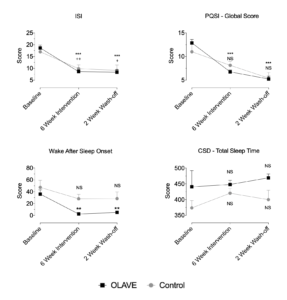Use of Open-Loop Audio-Visual Entrainment to Improve Chronic Insomnia in Adult Dayworkers with Normal Sleep Duration.
Accepted to be presented at the International Congress on Integrative Medicine and Health in Phoenix, AZ, May 2022 – ICIMH-2022.
Title:
Use of open-loop audio-visual entrainment to Improve Chronic Insomnia in Adult Dayworkers with Normal Sleep Duration.
Authors:
Michael Keown, Ph.D. Student1, Francisco Jose Cidral-Filho, Ph.D.2, Patrick Porter, Ph.D.1
- Postgraduate Programin Integrative Medicine. Quantum University. Honolulu, HI, USA.
- Laboratory of Experimental Neurosciences. University of Southern Santa Catarina, SC, Brazil.
Background:
Chronic primary insomnia is one of the most common sleep disorders among adults, including day workers, and is characterised by difficulties initiating (latency) and/or maintaining sleep as well as early morning awakening, which can result in daytime impairment. Aside from conventional pharmacotherapeutic and non- pharmacotherapeutic treatment, no complementary intervention has been found to treat chronic ‘primary’ insomniac adults with normal sleep duration (> 6h). Previous studies have found that open-loop audio-visual entrainment (OLAVE) potentially reduces excessive hyperarousal that is thought to contribute to difficulties with impairment at daytime and initiating and maintaining sleep at nighttime.
Objective:
The goal of this study was to assess the efficacy of open-loop audio-visual entrainment to improve chronic insomnia in adult dayworkers with normal sleep duration.
Methods:
Fifteen middle-aged day workers were randomly assigned to one of two intervention groups: OLAVE (n = 8, with the Braintap Headset – New Bern, NC) or CONTROL (n = 7) (placebo group) for a period of 6 weeks. Both groups attended six, weekly sessions, during the day, at the same time and day of the week. During the 10-week trial, participants completed four different questionnaires including three self-assessment questionnaires for insomnia symptoms, sleep quality and emotional impairment, and a sleep diary. Actigraph, heart rate and heart rate variability readings were also recorded during the intervention.
Results:
After 6 weeks, between-group differences were found in sleep fragmentation (Wake After Sleep Onset – WASO, p=0.04) and sleep quality (Pittsburgh Quality of Sleep index – PSQI, p<0.0001; Consensus Sleep Diary – CSD, Total Sleep Time Subset, p=0.004) in the OLAVE group. Within-group differences showed that both groups reported some improvement in sympathovagal balance and significant improvements in insomnia symptoms (Insomnia Severity Index – ISI, p<0.05) and emotional reactivity (impairment) (p<0.05), which continued to the end of the trial. Improvement in sleep quality (PSQI, p<0.001, CSD, p<0.01), WASO (p<0.01) and sleep efficiency (p<0.05) in the OLAVE group were reported at the 2-week post-intervention period.
Conclusion:
Results suggest that OLAVE technology used during daytime may be efficacious in improving chronic insomnia in adult dayworkers with normal sleep length. Further exploration of OLAVE as a non-pharmacotherapeutic intervention for reducing chronic insomnia in adult dayworkers is warranted.
Graphs

Figure 1 – The use of open-loop audio-visual entrainment to Improve Chronic Insomnia in Adult Dayworkers with Normal Sleep Duration. Effects upon Insomnia Severity Index (ISI), WASO (Wake After Sleep Onset), Pittsburgh Quality of Sleep index (PSQI), Consensus Sleep Diary (CSD, Total Sleep Time Subset). When comparing within-group differences with Baseline: NS = Not statistically significant, **p<0.01, ***p<0.001 for OLAVE group; +p<0.05, ++p<0.01 for Control Group (Two-way ANOVA repeated measures followed by Bonferroni post-hoc Test – Graphpad Prism software, USA).
